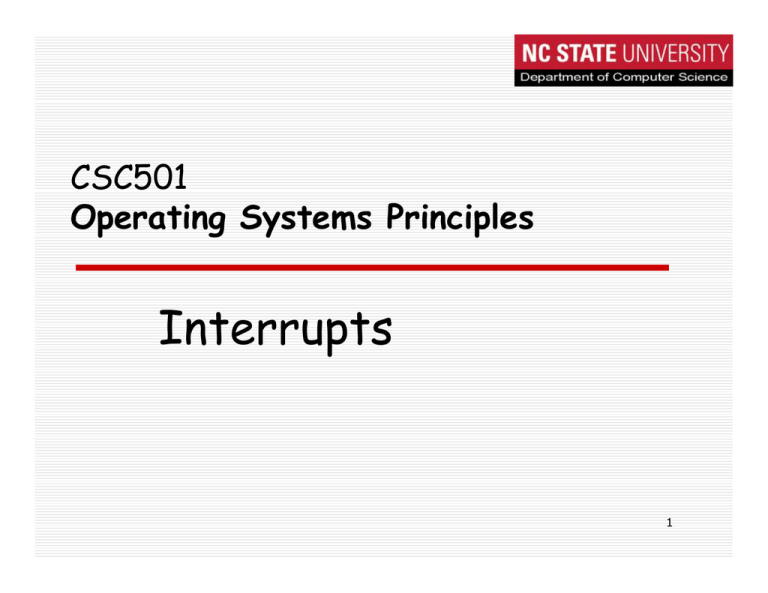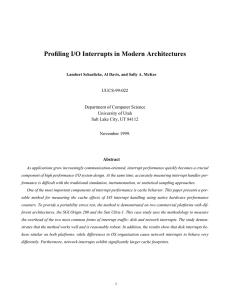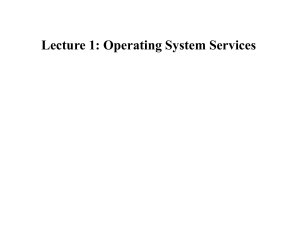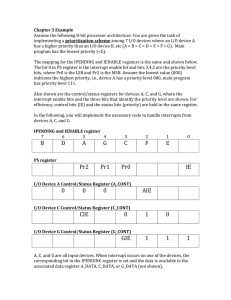Interrupts
advertisement

CSC501 Operating Systems Principles Interrupts 1 Last Lecture q Deadlock Q Necessary Conditions Q Solutions q Today Q Interrupts Question: Why do we need interrupts? 2 Introduction q Interrupts provide an efficient way to handle unanticipated events and improve processor utilization q Interrupts alter a program’s flow of control Q Interrupt causes transfer of control to an interrupt service routine (ISR) v ISR is also called a handler Q When the ISR is completed, the original program resumes execution Q Behavior is similar to a procedure call v Some significant differences between the two 3 Interrupts vs. Procedures q q q q q Interrupts Initiated by both software and hardware Can handle anticipated and unanticipated internal as well as external events ISRs or interrupt handlers are memory resident Use numbers to identify an interrupt service eflags register is saved automatically q q q q q Procedures Can only be initiated by software Can handle anticipated events that are coded into the program Typically loaded along with the program Use meaningful names to indicate their function Do not save the eflags register A Taxonomy of Pentium Interrupts Difference: q Depending on the way they are reported q Whether or not the interrupted instruction is restarted Interrupt Taxonomy q Exceptions Q Faults, Traps, and Aborts q Software Interrupts q Hardware Interrupts 6 Exceptions: Faults, Traps, and Aborts q Faults Q Instruction boundary before the instruction during which the exception was detected Q Restarts the instruction q Examples: Q Page fault Q Segment-not-found fault Exceptions: Faults, Traps, and Aborts q Traps Q Instruction boundary immediately after the instruction during which the exception was detected Q No instruction restart q Examples: Q Overflow exception (interrupt 4) is a trap Q User defined interrupts are also examples of traps Exceptions: Faults, Traps, and Aborts q Aborts Q No precise location of the instruction that caused the exception Q No instruction restarting Q Reporting severe errors such as hardware errors and inconsistent values in system tables qExamples: QMachine check QDouble fault 9 Dedicated Interrupts q Several Pentium predefined interrupts --called dedicated interrupts q These include the first five interrupts: interrupt type Purpose 0 Divide error 1 Single-step 2 Non-maskable interrupt (NMI) 3 Breakpoint 4 Overflow Dedicated Interrupts (cont’d) q Single-Step Interrupt QUseful in debugging QTo single step, Trap Flag (TF) should be set QCPU automatically generates a type 1 interrupt after executing each instruction if TF is set QType 1 ISR can be used to present the system state to the user Dedicated Interrupts (cont’d) q Breakpoint Interrupt QUseful in debugging QCPU generates a type 3 interrupt QGenerated by executing a special single-byte version of int 3 instruction (opcode CCH) Interrupt Taxonomy q Exceptions q Software Interrupts q Hardware Interrupts 13 Software Interrupts q Initiated by executing an int instruction, where the interrupt number is an integer between 0 and 255 q Each interrupt can be parameterized to provide several services. Q For example, Linux interrupt service int 0x80 provides a large number of services (more than 330 system calls!) v EAX register is used to identify the required service under int 0x80 Hardware Interrupts q Software interrupts are synchronous events Q Caused by executing the int instruction q Hardware interrupts are asynchronous in nature Q Typically caused by applying an electrical signal to the processor chip q Hardware interrupts can be Q Maskable Q Non-maskable How Are Hardware Interrupts Triggered? q Maskable interrupt is triggered by applying an electrical signal to the INTR (INTerrupt Request) pin of Pentium Q Processor recognizes this interrupt only if IF (interrupt enable flag) is set Q Interrupts can be masked or disabled by clearing IF q Non-maskable interrupt is triggered by applying an electrical signal to the NMI pin of processor Q Processor always responds to this signal Q Cannot be disabled under program control How Does the CPU Know the Interrupt Type? q Interrupt invocation process is common to all interrupts QWhether originated in software or hardware q For hardware interrupts, processor initiates an interrupt acknowledge sequence Qprocessor sends out interrupt acknowledge (INTA) signal QIn response, interrupting device places interrupt vector on the data bus QProcessor uses this number to invoke the ISR that should service the device (as in software interrupts) How Can More Than One Device Interrupt? q Processor has only one INTR pin to receive interrupt signal q Typical system has more than one device that can interrupt --- keyboard, hard disk, floppy, etc. q Use a special chip to prioritize the interrupts and forward only one interrupt to the CPU Q 8259 Programmable Interrupt Controller chip performs this function Interrupt Processing q How many interrupts can be supported? Q Up to 256 interrupts q Interrupt number is used as an index into the Interrupt Descriptor Table (IDT) Q This table stores the addresses of all ISRs Q Each descriptor entry is 8 bytes long v Interrupt number is multiplied by 8 to get byte offset into IDT Q Location: v Protected mode: anywhere in memory IDTR Detailed Steps in Interrupt Processing q Step 1: Save the current machine state q Step 2: Load the machine state for interrupt handling q Step 3: Invoke the corresponding ISR q Step 4: Resume the program execution Question: Why do we need to save the current machine states? 20 Step 1: Save the Current Machine State q Push the EFLAGS register onto the stack q Clear interrupt enable and trap flags Q This disables further interrupts Q Use sti to enable interrupts q Push CS and EIP registers onto the stack Question: Where are these states saved? Step 2: Load the Machine State for Interrupt Handling q Load CS with the 16-bit segment selector from the interrupt gate q Load EIP with the 32-bit offset value from the interrupt gate Question: How to locate and load the machine states for interrupt handling? Protected Mode Interrupt Processing IDTR Organization of the IDT Protected Mode Interrupt Processing q IDTR contains the memory location of IDT q IDTR is a 48-bit register Q 32 bits for IDT base address Q 16 bits for IDT limit value v IDT requires only 2048 (11 bits) v A system may have smaller number of descriptors n Set the IDT limit to indicate the size in bytes q Two special instructions to load (lidt) and store (sidt) IDT Q Both take the address of a 6-byte memory as the operand Protected Mode Interrupt Processing Interrupt descriptor Protected Mode Interrupt Processing Interrupt invocation Step 3: Invoke the ISR q ISR: Interrupt-specific service routine q Examples: Q Q Q Q Q Single-step Breakpoint Timer Page fault … 27 Step 4: Resume the Program Execution q What is the last instruction in an ISR: Q iret q The actions taken on iret are: Q pop the 32-bit value on top of the stack into EIP Q pop the 16-bit value on top of the stack into CS Q pop the 32-bit value on top of the stack into the EFLAGS register q As in procedures, make sure that your ISR does not leave any data on the stack Q Match your push and pop operations within the ISR An Example: q Timer interrupt handler Q Related files: sys/clkint.S sys/clkinit.c Q Interrupt rate – based on clock timer v ctr1000: 1ms Q Scheduling rate: v Interrupt rate * QUANTUM q You will be familiar with page fault handler in Lab 3! q Others: sys/evec.c 29 Next Lecture q Midterm Review 30







